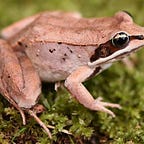Amphibian Advocate — Karpathos Frog
It is with a truly heavy heart that I bring to you this week’s edition of Amphibian Advocate, because this week I will be covering “the most endangered frog in Europe”, and one of the most endangered frogs in the world, the Karpathos Frog.
Karpathos Frog — Are We Too Late to Save One of Europe’s Most Endangered Amphibians?
The Karpathos Frog (Pelophylax cerigensis, so named for its sole habitat on the island of Karpathos in Greece) is, according to conservationists, the most endangered frog in Europe, which means it is also one of Europe’s most endangered species. The Karpathos frog is endemic to just one small area in northern Karpathos, with its habitat spanning less than 10 km² (less than 4 square miles), and because this habitat is so microscopic and remote, very little research has been done on the Karpathos Frog. Without adequate data, no conservation measures can be put in place to protect the Karpathos Frog, and though efforts have been made, there is (in my opinion) very little hope left for the survival of the Karpathos Frog, at least in the wild.
Taxonomy
The Karpathos Frog is a species of frog that was classified alongside its cousin the Cretan Frog by Beerli et al. in 1994. In the paper published alongside the frog’s official classification, the Karpathos Frog is listed as having an adult body length of 64.6 millimeters (about 2.5 inches) on average. Their bodies range in color from light gray to brown, and they are covered in brown or olive green spots. There is nothing stunning about gray with brown spots, but this coloration helps them blend in with the shrubs that surround the bodies of water they call home. To me, the Karpathos Frog’s most striking feature is its beautiful, bright golden eyes. It is suggested by Beerli et al. that the Karpathos Frog diverged genetically from its European cousins roughly three million years ago.
Habitat and Distribution
According to AmphibiaWeb, The Karpathos Frog is endemic to very small area in the north of the Greek island of Karpathos, where it lives primarily in still pools and intermittent lakes (meaning a lake that is dry for part of the year) near rivers. The natural habitat of this frog is rocky and shrub covered, and though it is a beautiful island in the Aegean Sea, it would not be a stretch to call Karpathos a harsh environment for a frog on the brink of extinction. It is unknown exactly how far the distribution of the Karpathos Frog extends, but according to the International Union for the Conservation of Nature (IUCN), their habitat and distribution are decreasing due to commercial development, natural resource harvesting, and climate change to name a few factors. It has been speculated that some Karpathos Frogs may live in a protected area of Karpathos, but this information is unconfirmed as of September 19th, 2021.
Conservation Status
The Karpathos Frog is listed by the IUCN as “Critically Endangered”. This is the first time that we have covered a creature that is listed as being of significant concern to the IUCN, and it is listed as such for good reason. It is assumed that the population size of the Karpathos Frog has always been relatively small, as it is a species that lives isolated on a single island in Greece in an uninviting and oft-predated habitat, but exactly how small the population is has yet to be determined. in 2019 researchers wrote that the entire population was “a few hundreds”. The Karpathos Frog was originally listed as “Endangered” in 2004, (10 years after its discovery) and was moved to its current “Critically Endangered” status five years later in 2009.
The small population of remaining Karpathos Frogs went largely unmonitored from the time they were classified in 1994 to the early-mid 2010s. Since then, very little effort has been made to conserve the existing population of Karpathos Frogs. A paltry amount of research has been conducted (with good intentions), but I cannot honestly say that I believe it is enough effort to save the remaining population. According to a publication from 2019 cited by the IUCN, there is a translocation program in the works for these frogs that would see them moved to more inhabitable areas of the island in an effort to increase the birthrate and monitor/study the species more closely, but the legislation associated with that program is still in its infancy.
What Can You Do?
This is the part of Amphibian Advocate where in the past I have recommended that you lobby your local government official, or fund conservation research, but I’m afraid that this week neither of those things will help. I fear that we as a society may have discovered the Karpathos Frog too late, and that there is very little we can do to help it return to prosperity. The Karpathos Frog will very likely be one of the first extinctions associated with the modern climate change crisis, and though across the globe we are rallying behind efforts to stop or reverse climate change, it very well may be too late for at least one species of little gray-brown frog. If you made it this far in this week’s edition of Amphibian Advocate, you have access to as much research as is out there about the Karpathos Frog, and so I ask that if anything you think about what a shame that is. Though I can not speak on behalf of the Karpathos Frog, I can say for sure that it makes me happy to know that someone will be thinking about it as a result of this blog post.
For less somber writing about frogs and other amphibians, please see last week’s edition of Amphibian Advocate on the Eastern Hellbender!
